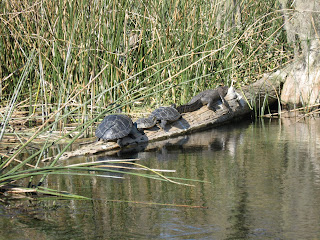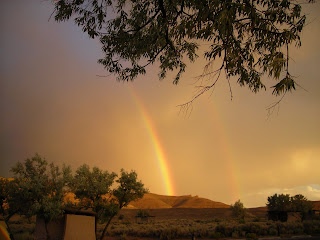Sequence stratigraphy, regardless of what one thinks of the specific methods, has played a major role in fundamentally changing the way we look at the stratigraphic record. It's a major conceptual framework that helps us interrogate the "time-as-rock" and "time-as-surfaces" relationships represented by the stratigraphic record, and has served as the dominant correlation strategy for much of the community of working sed/strat types.
So it's kind of a big deal.
Historiographically, the central concepts of the practice began with the work of Suess (1906), Blackwelder (1909), Barrell (1917), Wheeler (1958; 1964) and Sloss (1963). Despite these early works, however, "sequence stratigraphy" is represented (for good or bad) by the iconic 1977 AAPG Memoir 26, which brought the Exxon-ian Depositional Sequence to the conceptual and terminological landscape. And of all the contentious terms and ideas put forward by subsequent seq. strat. workers, perhaps none is more (in)famous than the dread Eustatic Sea Level Curve.
Eustatic sea-level curves have been used and abused in a variety of ingenious ways, and the literature is full of delightful arguments as to their merit and meaning. Sea-level curves are a complicated theoretical construct that really requires some serious and thoughtful interrogation. Or, alternatively, Sea-level curves are things you put up on the wall, and then match your particular rocks to your favorite wiggle. The community is divided as to which approach is correct.
Anyway, Haq et al. (1987) published the seminal Sea Level Curve for the Triassic and Younger; now, Haq and Schutter (2008) have put out a Paleozoic Sea Level Curve for our consumption. The paper, published in Science, is available
here. The real meat, including a pretty graph, is located in the Supplemental Online Text (SOM), available
here.Haq and Schutter (2008) produce a series of designated "Reference Districts", which in reality represent composite stratigraphic sections for the time intervals in questions; this is a necessity, as Paleozoic rocks are commonly seriously eroded and possibly deformed, required multiple stratigraphic sections to transect a larger chuck of time. These reference districts span the world, and are taken from the literature; the SOM details these and their references. Additionally, the authors identify Ancillary Sections, which are not in Reference Districts, but show the same interpreted sequences and surfaces.
Anyway, without further ado, below is their pretty Paleozoic Sea-Level Curve; both the figure and text are from the SOM to Haq and Schutter (2008):

To summarize the curve, Haq and Schutter identify a long-term sea-level trend that shows a gradual rise through the Cambrian, a zenith in the Late Ordovican, a rapid, short-lived sea-level low related to Hirnantian (~445 Mya) glaciation, with subsequent (though smaller) highs in the mid-Silurian, the Middle/Late Devonian, and in the Latest Carboniferous, and lows interpreted in the early Devonian, the Mississippian/Pennsylvanian boundary, and in the Late Permian. Overall magnitude of the 170+ eustatic events is interpreted by the authors to range from a few meters to ~125 m.
The authors do acknowledge a couple of potential issues with their work: first and foremost, they are very up-front about the difficulty of interpreting magnitudes of change from the rocks, particularly from aerally disparate outcrops with often complex unconformity relationships. The authors also recognize the difficulty of chronostratigraphic and geochronological calibrations, particularly given that the biostratigraphy of these sections is often complex and dominated by endemic, restricted faunas.
Haq and Schutter also cut-off one of the loudest (and, in some ways, most damning) criticisms made for the Haq et al. (1987) curve: the availability for reexamination of the data used in the analysis. The Triassic and younger curve was commonly criticised for the proprietary seismic data used to calibrate coastal onlap; in other words, you kind of had to take the authors' word on their interpretations, because Exxon sure wasn't going to hand over the data. In this 2008 paper, however, Haq and Schutter make a special point of noting that these sections are "public-domain", in that they are freely accessible to other workers who want to go look at them.
Admirable though that recognition may be, the fact of the matter is that this opens up other problems. Namely, this work is a meta-analysis, and therefore, subject to all the prejudices and problems that sort of broad-brush examination are subject to. In the SOM, Haq and Schutter cite 82 primary sources for their Reference Districts (which form the core of their interpretations), and a subsequent 192 for their Ancillary Sections. While that's a lot of papers, a perusal of the work shows a dominance of North American sections, with Australian sections coming in a close second. The statistical significance of the dataset is therefore complicated by the geographic and temporal distribution of the sections, which are already on the low end for a global synthesis anyway. At some point, we as a discipline are going to have to ask ourselves about the suitability of meta-analyses for geological or stratigraphic studies.
Furthermore, the old "tectonically quiescent" thing is a problem, particularly given the publication of a couple of papers that specifically refute the existence of such settings at the applicable time-scales (specifically, Cogne and Humler, 2008 and Moucha et al., 2008, both in EPSL). The argument for these settings always comes off as a little circular: we get a eusatic sea-level curve, so these settings must be tectonically quiet, right? Given the problems with actually backstripping some of these settings (which, to their credit, Haq and Schutter do acknowledge), the attribution of accommodation creation to eustasy seems suspect.
The biggest potential hurdle, to me at least, seems to be deconvolving the accommodation curve from the sediment supply curve; simple changes in sediment delivery to the coast can produce a coastal onlap curve. Without at least mentioning it, let alone actually interrogating the potential impact on your curve, I really can't suss out how important a factor it is in your sections. This was the point of Christie-Blick (1991), which seems to be a constantly unanswered challenge to these onlap curves.
There is obviously a very interesting story to be found in the record of Phanerozoic sea-level changes; the fact that many of these studies have found inexplicable high-frequency, high-magnitude changes during decidedly non-glacial phases suggests that there are still poorly understood depositional and stratigraphic principles out there (though these MAY be of the sed supply:accommodation ratio nature, rather than any crazy unknown water cycle issue). Also, the utility of accurately and unequivocally pinning down the history of eustatic sea level changes has important implications across a variety of earth science disciplines. Here's hoping that this work re-energizes the community!

























































